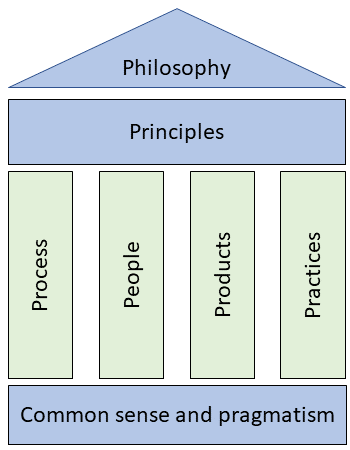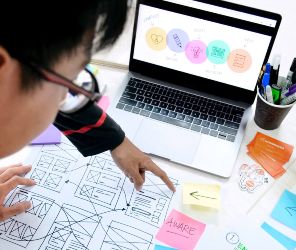
Emergence of DSDM
Dynamic Systems Development Method (DSDM) is often perceived as a hidden gem in the world of Agile.
Introduced in 1995, DSDM holds the distinction of being the most time-tested Agile method and is the only method dedicated to managing Agile projects.
In the early 2000s, DSDM gained prominence among software developers looking for alternatives to rapid application development (RAD) approaches. One significant issue with RAD was its poor scalability for team collaboration. DSDM resolved this by encouraging collaboration within teams and at scale, making it one of the first Agile methodologies employed within the software development community.
DSDM played a role in the birth of the Agile Alliance and the Agile Manifesto in 2001. Its principles and philosophy contributed to the development of the Manifesto for Agile Software Development, even though DSDM expands the Agile concept beyond just software.
In summary, DSDM embodied Agile before the term became a household name!
DSDM Atern Unveiled
In 2007, a substantial update to the DSDM approach introduced DSDM Atern. The term ‘Atern’ was coined from the Arctic Tern, a bird renowned for its highly collaborative character and the ability to journey across vast distances. This metaphor aptly encapsulated the rebranding of the DSDM method.
In 2014, due to confusion over the term ‘Atern,’ another revision to the method was carried out. The decision was made to return to the original DSDM name, which was widely recognized. As such, DSDM and DSDM Atern now bear the same meaning!
Embracing the Agile Project Framework in DSDM
During the 2014 rebranding of DSDM, the Agile Project Framework was introduced. The DSDM Agile Project Framework has become the leading, proven agile approach that fulfills the dual demands of contemporary organizations: governance and rigor, as well as agility and adaptability.
The Agile Project Framework in DSDM helps organizations tackle common project issues, such as late deliveries, budget overruns, or final deliverables that don’t meet the intended purpose.
The Advent of AgilePM in DSDM
DSDM was the first agile framework to incorporate agile project management capabilities. Unlike Scrum, which centers on product delivery during an iteration, DSDM also addresses project management aspects, distinguishing it from most other agile frameworks.
DSDM’s ability to fulfill a range of agile requirements led to its selection as the basis for the rapidly expanding AgilePM (Agile Project Management) qualifications, which are accredited by APMG International and the Agile Business Consortium.
DSDM – Agile Framework
DSDM is a cyclical agile framework initially developed for delivering software projects more efficiently. Like other agile frameworks and methodologies, DSDM emerged as a response to the challenging waterfall processes that dominated the software development industry during the late 20th century.
DSDM’s Success
DSDM is now thriving as agile methodologies have evolved. This is due to organizations needing increased rigor and control when applying agile in situations where the ‘ideal agile environment’ is absent.
DSDM is an agile method that addresses the requirements of both simple product development projects with co-located teams, and more complex projects involving multiple distributed teams working in various countries and time zones. DSDM can scale up to handle multiple teams working in dispersed environments, something that scaled agile frameworks have only recently started providing.
DSDM Core Aspects
Not Confined to IT
DSDM’s background, like most agile frameworks and methods, is rooted in the software development industry. However, over the last decade, agile has broadened its scope and is no longer confined to IT.
DSDM can easily be applied to projects outside of software development. In fact, it can be implemented in any type of product development project. By delivering a usable product incrementally at the end of each timebox, DSDM can provide business value early in the product development lifecycle.
DSDM: Independent or Synergistic
The DSDM Agile Project Framework can be used either as an independent method or combined with other well-known project management methods such as PRINCE2, MSP, and PMI.
It is also an excellent wrapper for more limited Agile approaches like Scrum, ensuring that the entire project lifecycle is covered. DSDM also enables Scrum to be scaled up for use beyond just product development.
DSDM Components

DSDM is an agile project framework that includes several elements:
- philosophy
- principles
- people
- process
- products
- practices
- pragmatism and common sense.
Together, these elements underpin a philosophy of delivering business benefits as early as possible, ensuring the best possible return on investment (ROI) for an organization.
DSDM’s ‘sensibility and pragmatism’ might seem odd to some people, but this flexibility helps DSDM avoid the rigidity that sometimes characterizes other Agile approaches.
A key assumption of DSDM is that nothing is built perfectly on the first try. As a general guideline, 80% of a solution’s value can be delivered for 20% of the effort needed to produce the complete solution.
By concentrating on the business need, DSDM supports projects that strategically align with an organization’s change portfolio.
DSDM Essential Principles
DSDM encompasses 8 essential principles that define its character, culture, and mode of operation. These principles must be actively maintained throughout a project because compromising any principle can endanger the successful execution and completion of a project.
DSDM closely follows agile principles, centering on delivery, effective communication, collaboration, and continuous delivery. All DSDM principles help to integrate DSDM practices with the agile philosophy.
Learning the guiding principles of DSDM is critical if you aim to take an agile project management course like AgilePM®, which is founded on the DSDM method.
We will now look at the 8 DSDM principles.
1. Focus on the business need
- Understand business priorities.
- Create a valid business case.
- Enable continuous business commitment.
All decisions taken during the project should be in line with the overall project aims. Projects should act as a vehicle to achieve long-term business objectives. Approaches like MoSCoW and timeboxing help maintain focus on delivering what the business demands and when it demands it.
2. Deliver on time
- Use timeboxing.
- Focus on priorities.
- Predict deliveries.
Timely product delivery is often mandatory. For dependable deliveries, pre-plan all timeboxes. Features might differ, but the delivery dates should always be consistent.
3. Cooperate and collaborate
- Promote stakeholder collaboration.
- Focus on team building.
- Work with business representatives.
Teams ought to collaborate seamlessly and decide on behalf of the individuals they stand for. Ensure the presence of subject matter experts in your team to promote information exchange. Stakeholders may contribute their insights and experiences to project teams by participating in regular workshops.
4. Never compromise quality
- Set quality level at the start.
- Ensure quality doesn’t vary.
- Document and test.
Set the target quality level at the project’s onset. All actions should contribute towards attaining this agreed standard. Examine deliverables promptly and regularly reevaluate them.
5. Build incrementally
- Deliver business benefit early.
- Reassess priorities with each iteration.
- Confirm that the work is correct.
DSDM insists that teams must first familiarize themselves with the extent of the business problem before proceeding with development. Refrain from overanalyzing requirements to the point that development is obstructed.
6. Develop iteratively
- Use customer feedback.
- Create Enough Design Up Front (EDUP).
- Evolve and be creative.
DSDM is based on the principle of iterative delivery. Recognize that achieving perfection on the first try is uncommon, and being open to modifications within your project is essential for success.
7. Communicate continuously
- Manage expectations.
- Keep documentation simple.
- Interact through workshops.
Cultivate team engagement through stand-ups and workshops. Present your work frequently and early by leveraging models and prototypes. Support continuous informal, in-person communication among team members.
8. Demonstrate control
- Be proactive.
- Timebox work and review regularly.
- Evaluate project viability.
Amplify project management by offering transparency in plans and progress to all team members. Utilize formal documentation techniques. Measure progress based on the products delivered, rather than tasks finalized.
DSDM Processes
DSDM relies on iterative and incremental principles. The most critical business needs are delivered first, followed by less important ones later on.
Through its iterative approach, DSDM allows business representatives to keep track of a solution’s evolution, offer feedback, and request changes as it continues to develop.
Phases
The DSDM process model includes 6 distinct phases. It stands out from many other Agile approaches due to the presence of a pre-project phase and post-project phase, which go beyond mere delivery.
The phases of DSDM are:
- Pre-project.
- Feasibility.
- Foundations.
- Evolutionary development.
- Deployment.
- Post-project.
People
DSDM engages individuals from business and development realms throughout the entire iterative and incremental lifecycle.
Everyone involved in a project is assigned specific roles and duties and cooperates within timeboxes to keep the project on track.
DSDM sets itself apart from other Agile approaches by defining the project manager’s obligations.
Practices
DSDM suggests 4 key practices.
Timeboxing
Like various agile frameworks, DSDM plans work within fixed timeframes (timeboxes), similar to sprints in Scrum. The intention is to deliver a functional product at the end of each iteration (timebox). As such, DSDM employs both an incremental and iterative methodology for product development.
Facilitated workshops
Facilitated workshops involve project stakeholders in a collaborative effort to define business requirements and facilitate mutual understanding.
Modelling and iterative development
Modelling helps team members visualize a business domain and expand their knowledge of it. Modelling is utilized for crafting diagrammatic representations of particular aspects of the system or business area under development.
DSDM depends on a short feedback loop with the customer to deliver a working software increment at the conclusion of each iteration. The MoSCoW prioritization technique is advised for organizing requirements to be addressed by the team during a timebox, which are usually documented as user stories.
Prototyping is a key component of DSDM. The aim is to quickly develop a product, gather feedback swiftly, and uncover any potential problems sooner rather than later. The core DSDM philosophy underscores the value of identifying what might not be successful as early as possible, allowing for prompt course corrections.
MoSCoW prioritization
MoSCoW prioritization assists organizations in categorizing requirements by identifying Must have, Should have, Could have, and Won’t have items within each timebox.
Comparing DSDM and Scrum
There is often confusion in the Agile community about Scrum’s role in project management. Some believe that Scrum is a project management approach, but it is actually a development method centered on enabling teams to collaborate on project and non-project tasks to iteratively deliver valuable products to customers.
Scrum does not provide guidance on the activities preceding a project (pre-project) or following the deployment of a solution (post-project). The pre-project stage requires consideration of the project’s value, while the post-project stage involves evaluating the benefits of the solution and identifying any required improvements.
In contrast, DSDM addresses both the pre-project and post-project stages, as well as the responsibilities of the project manager. DSDM serves as an agile project management framework, while Scrum is a product delivery framework. Nonetheless, Scrum can be employed within DSDM projects during the other four project phases.
DSDM infographic
The following infographic shows the DSDM principles in greater detail.

Summary
The DSDM Agile Project Framework is a proven and reliable approach to agile project delivery, having been successfully adopted in numerous projects around the world.
Currently, DSDM is the only agile project management framework in the market. The framework has consistently displayed its capacity to work effectively within and alongside existing corporate processes.
With a history dating back to 1994, DSDM has been used in both IT and non-IT projects, resulting in considerable productivity increases, as independently corroborated by the UK Software Metrics Association.
For more information on how DSDM can support your Agile project delivery, or for information about agile project management training, please reach out to us at agileKRC.
agileKRC has helped shape agile thinking by leading the teams that developed AgilePM® and PRINCE2 Agile®. We take a practical, success-oriented approach. We begin by taking the time to listen and understand your needs, before offering our real-world experience and expert guidance.













